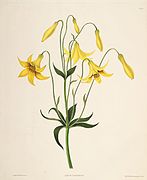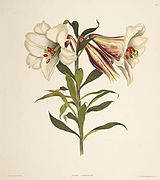Priscilla Susan Bury
Priscilla Susan Bury | |
|---|---|
| Born | Priscilla Susan Falkner 12 January 1799 Liverpool, England |
| Died | 8 March 1872 (aged 73) Croydon, England |
| Nationality | United Kingdom |
| Occupation | Botanist and Illustrator |
| Spouse(s) | Edward Bury |
Priscilla Susan Bury, born Falkner (12 January 1799 Liverpool – 8 March 1872 Croydon), was an English botanist and illustrator.
Personal life[]
Priscilla Susan Bury was born in Rainhill, Liverpool.[1] Her parents were Edward Falkner and Bridget (née Tarleton) Falkner.[2]
She married Edward Bury (1794-1858), a noted railway engineer, on 4 March 1830. The couple had at least three sons, born between 1831 and 1835. Between 1852 and 1860 the family lived at Hillsborough Hall near Sheffield and later moved to Croft Lodge, Ambleside in the Lake District.
In 1860 she published an account of her husband, Recollections of Edward Bury, Fellow of the Royal Society, Member of the institute of Civil Engineers, Member of the Smeatonian Society, Fellow of the Royal Astronomical Society, Fellow of the Royal Historic Society by his widow.[3]
By 1866 she had moved to Fairfield, Thornton Heath, Croydon where she died of bronchitis and cerebral congestion on 8 March 1872.[4]
Artistic work[]
Although she was not trained as a botanist or commissioned as a professional artist,[5] she was the author of several artistic and scientific plant illustrations[6]
She began to draw plants from the glasshouse at her family home 'Fairfield',[1] and by 1829 had enough studies of lilies and allied plants for publication. The 1829 Drawings of lilies, as lithographs by Hullmandel, features her illustrations accompanied by short notes.[1] This was modelled on a book, and its publicity materials, by William Roscoe.[4]
From 1831 to 1834, her drawings were published in A Selection of Hexandrian Plants.[7] The engraving was entrusted to the Londoner Robert Havell, engraver of the John James Audubon (1785-1851) plates. The book was carried out in aquatint and the 350 plant drawings painted in part by hand. The subscribers to this large folio numbered only 79, mostly from the Lancashire region, Audubon being one of them. The book was described as "one of the most effective colour-plate folios of its period" by Wilfrid Jasper Walter Blunt in his The Art of Botanical Illustration.[8]
Her later work after 1836 consisted of eight plates for Maund and Henslow's The Botanist[9] and photographs of her drawings were included in Figures of Remarkable Forms of Polycystins, or Allied Organisms, in the Barbados Chalk deposit in 1860–1861, followed by new expanded editions in 1865 and 1869.[1] The fossils had been collected by John Davy and prepared for microscopy by Christopher Johnson of Lancaster.[4]
Gallery[]

Hippeastrum correiense

Hippeastrum ×johnsonii

Lily in A Selection of Hexandrian Plants

Lilium canadense

Lilium brownii var. viridulum

Hippeastrum Striatum

E.F. Seedling Amaryllus, 1819. Minneapolis Institute of Art
Bibliography[]
- 1859: Recollections of Edward Bury, by his Widow (Privately published, Windermere)
- 1862: Figures of Remarkable Forms of Polycystins, or allied organisms, in the Barbados Chalk Deposit; drawn by Mrs. Bury. Windermere: John Garnett, [1862]
Sources[]
- ^ Jump up to: a b c d "Bury, Priscilla Susan 1799 - 1872". Science Museum Group Collections. Retrieved 18 July 2020.
- ^ Batsaki, Yota; Tchikine, Anatole; Celnik, Leib; Chaivaranon, Ariana. "Margaret Mee: Portraits of Plants". Dumbarton Oaks. Retrieved 17 July 2020.
- ^ "Recollections of Edward Bury by his widow". Science Museum Group Collections. Retrieved 18 July 2020.
- ^ Jump up to: a b c Mabberley, DJ (2004). "Bury [née Falkner], Priscilla Susan". Oxford Dictionary of National Biography (online ed.). Oxford University Press. doi:10.1093/ref:odnb/56450. (Subscription or UK public library membership required.)
- ^ "Priscilla Susan Bury - Audubon House Gallery of Natural History". Audubon House Gallery of Natural History. Retrieved 2018-04-09.
- ^ "Biodiversity Heritage Library citation".
- ^ "A selection of Hexandrian plants, belonging to the natural orders Amaryllidae and Liliacae". Biodiversity Heritage Library.
- ^ Blunt, Wilfrid (1950). The Art of Botanical Illustration. London: Collins. p. 213.
- ^ The LuEsther T. Mertz Library
- ^ IPNI. Bury.
Works cited
- Brent Elliott (2001). Flora. Une histoire illustrée des fleurs de jardin. Delachaux et Niestlé (Lausanne): 335 p.
External links[]
| Wikimedia Commons has media related to Priscilla Susan Bury. |
- Saint Louis Art Museum General background. Image from Hexandrian Plants
- Edinburgh University Press
- A Selection of Hexandrian Plants
- Biodiversity Heritage Library Flickr
- - Baptism Record
- English botanists
- Botanical illustrators
- 1799 births
- 1872 deaths
- Scientists from Liverpool
- 19th-century British women scientists
- Women botanists
- People from Wavertree







